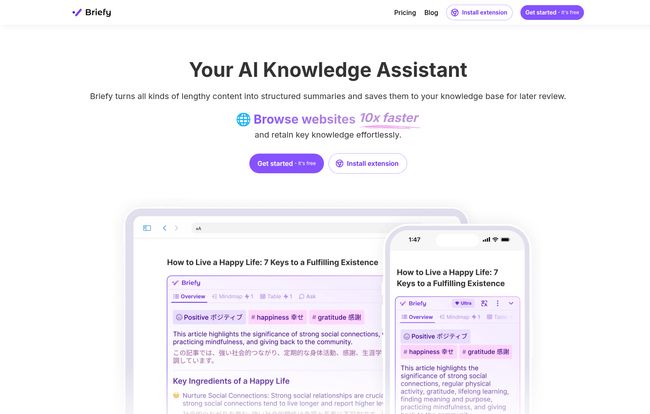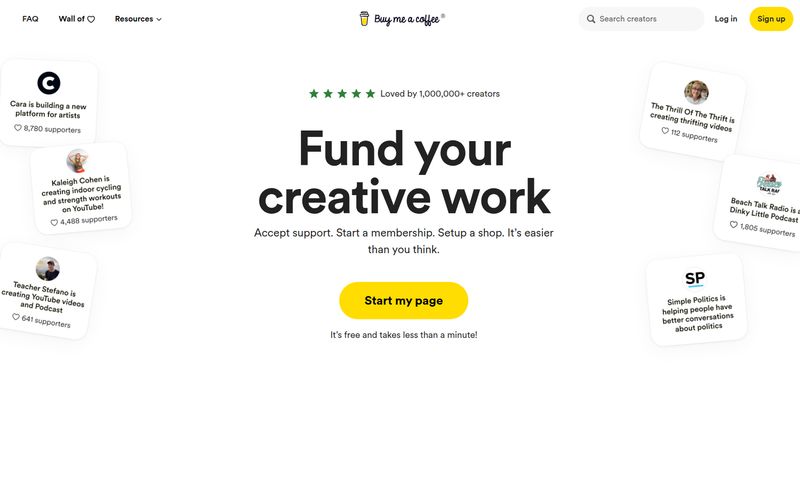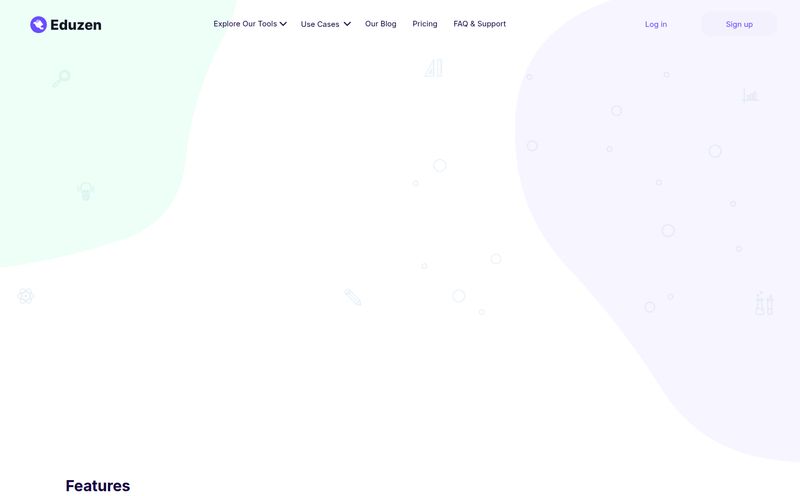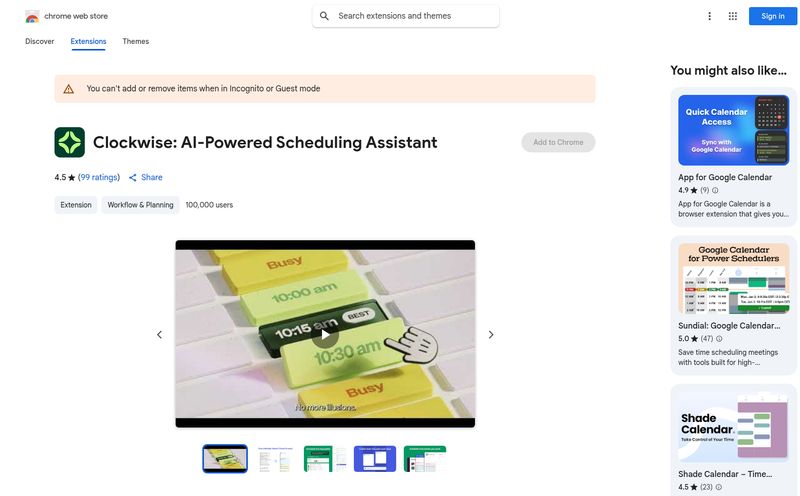Some days, my browser looks like a crime scene. I've got 47 tabs open, each one a rabbit hole of 'must-read' industry reports, competitor analyses, and that one long-form YouTube tutorial I swear I'll get to. The pressure to stay informed in the SEO game is immense, but the firehose of content never, ever stops. It's a classic case of information overload, and frankly, it's exhausting.
I'm always on the lookout for tools that don't just add another layer of complexity but actually give me back time and mental bandwidth. So when I stumbled upon Briefy, an AI tool that claims to be a “knowledge assistant,” my curiosity was piqued. Another AI summarizer? Maybe. But the promise was a bit different. It wasn't just about shortening text; it was about structuring it. I decided to take it for a spin, and well, the results were interesting enough that I had to write about it.
What Exactly is Briefy and How Does It Work?
At its core, Briefy is an AI-powered tool that, you guessed it, summarizes stuff. But calling it just a summarizer feels a bit like calling a Swiss Army knife just a knife. It’s a browser extension (for Chrome and Safari) that sits quietly in your toolbar until you land on a webpage, a YouTube video, or a PDF that's just too dense to tackle at the moment.
With a click, it gets to work, reading, watching, or scanning the content and then spitting out a structured, digestible summary. The real magic, for me, isn't just that it shortens content. It's how it does it. It transforms a sprawling article into a neat overview, a table, or even a mind map. It's less about deletion and more about translation—translating overwhelming content into something your brain can actually process.
The Features That Actually Matter (for Busy People)
Okay, let's get into the nitty-gritty. A tool can have a million features, but only a few usually make a real difference in your day-to-day workflow. Here’s what stood out to me with Briefy.
More Than Just a Wall of Text: The Different Summary Views
This was the first thing that made me go, “Oh, okay, this is different.” Instead of just giving you a paragraph of condensed text, Briefy offers several ways to view the information. You can get a standard overview, a neat table (amazing for comparing features or data points), a visual mindmap, or a timeline. It’s like having a team of analysts who present the same data in different formats depending on what you need. For a visual thinker like me, the mindmap feature is a godsend for breaking down complex topics. For analyzing competitor service pages, teh table view is just brilliant.
The Knowledge Base: Your Personal Digital Librarian
Here’s the feature that I believe turns Briefy from a neat gadget into an indispensable tool. Every summary you create can be saved to your personal Knowledge Base. Think about that for a second. It's not just a one-and-done summary. You're building a searchable, personal library of insights from everything you've read.
Imagine doing a huge competitor research project. You can summarize the top 20 articles on a topic, save them all to your Knowledge Base, and then search across all of them for specific keywords or themes. This transforms a fleeting summary into a permanent, valuable asset. It’s the difference between taking notes on a napkin versus filing them in a searchable database. For long-term projects, this is a game-changer.

Visit Briefy
Asking Questions and Getting Answers
Sometimes a summary isn't enough. You have a specific question about the content. Briefy lets you “chat with the content,” so you can ask follow-up questions directly. For example, after summarizing a long article about Google's latest algorithm update, I could ask, “What did it say specifically about video content?” and get a direct answer pulled from the text. This is so much faster than skim-reading the whole document again with CTRL+F. It’s a more interactive way to pull out the exact information you need.
Who is Briefy Really For? Let’s Be Real.
The website says it’s for students, professionals, and content creators, which is true but a bit broad. In my experience, here's who gets the most juice for the squeeze:
- Students & Academics: This is a no-brainer. Sifting through dense research papers and academic journals just got about 10x faster.
- SEOs and Marketers: We live and die by information. Use it to summarize competitor strategies, lengthy marketing reports, webinar transcripts, and those monstrously long pillar pages you need to analyze. It cuts down research time significantly.
- Content Creators & Journalists: When you're researching a new piece, you might go through dozens of sources. Briefy helps you quickly vet them and pull out key stats and quotes, all while building that handy knowledge base for later.
- The "Curiously Overwhelmed": This is my term for pretty much everyone else. Anyone who feels like they're drowning in newsletters, articles, and think-pieces but genuinely wants to learn. This tool acts as a brilliant filter.
Let’s Talk Money: Briefy’s Pricing Plans
Alright, the all-important question: what's the damage? Briefy has a tiered system that seems pretty standard for SaaS tools these days.
There's a Free plan to get your feet wet. You get 30 credits a month, which is enough to summarize a handful of articles or a few short videos. The response speed is standard, and you get the basic summarization features. It’s a great way to see if you even like the workflow.
The Premium plan is where it gets serious. For $7.49/month (if you pay annually), you get a hefty 700 credits, a faster response speed, and access to the advanced features like exporting mindmaps, summarizing super-long text (up to 2M words), and handling bigger PDF files. For most professionals, this is the sweet spot. The price is less than two fancy coffees a month, and the time it saves you is worth way more than that.
Then there's the Ultra plan at $13.99/month (billed annually), which bumps you up to 1000 credits and lets you upload massive files (up to 50MB). This is probably for the true power users—research institutions, data analysts, or agencies that are constantly processing huge volumes of content.
The Not-So-Perfect Parts (Because Nothing Is)
I'm not here to sell you a dream. No tool is perfect, and Briefy has a few areas that could be better. The free plan's 30 credits can disappear very quickly if you're a heavy user, so it really is more of a trial than a long-term solution.
Also, some of the most exciting features are still listed as “coming soon.” The Gmail extension, in particular, is something I'm eagerly waiting for. The idea of summarizing those novel-length email chains with a click is incredibly appealing. But for now, it's just a promise. I’ll keep an eye on that.
Final Thoughts: Is Briefy a Must-Have Tool?
So, what’s the final verdict? I've tested a lot of AI tools that flash and sizzle but ultimately don't change my workflow. Briefy is different. It's a genuinely useful tool that addresses a very real, very modern problem.
It’s not a magic wand that will do your thinking for you. You still need to engage with the material. But it's a powerful lever. It clears the clutter, presents information in a way your brain can handle, and, most importantly, helps you build a lasting, searchable repository of knowledge. That last part is what elevates it from a cool gadget to a professional-grade asset.
The feeling of closing 20 tabs because you've already captured their essence in your Briefy knowledge base is, and I don't say this lightly, pure bliss. In a world where the currency is attention, a tool that helps you focus it is worth its weight in gold.
Frequently Asked Questions about Briefy
How does Briefy actually work?
Briefy uses artificial intelligence to analyze the content of a webpage, video, or document. It identifies the main ideas, key points, and supporting details and then reconstructs them into a shorter, structured format like an overview, table, or mindmap.
What types of content can Briefy summarize?
Currently, Briefy supports summarizing webpages, YouTube videos, and PDFs. They also have a Gmail summarizer listed as a feature that is coming soon, which would allow you to summarize long emails.
Is Briefy free to use?
Yes, there is a free plan available. It gives you 30 credits per month to try out the basic features. For more frequent use and advanced features like the Knowledge Base and different summary views, you'll need to upgrade to a paid plan like Premium or Ultra.
What makes Briefy different from other AI summarizers?
Its main differentiators are the multiple summary formats (mindmap, table, timeline) and the integrated Knowledge Base. Most summarizers just give you a block of text and the interaction ends there. Briefy helps you save, organize, and search your summaries over time, turning it into a long-term research tool.
Is my data safe with Briefy?
Like with any cloud-based tool, it's smart to be mindful. According to their site, they are focused on security. However, as a general rule, I would avoid summarizing documents with highly sensitive personal or financial information on any third-party platform. For general articles, research, and public content, it's perfectly fine.
When will the Briefy for Gmail feature be available?
The Briefy website lists the Gmail integration as “coming soon.” There isn't a specific release date mentioned, so it's best to check their website or subscribe to their updates for the latest news on that feature.



